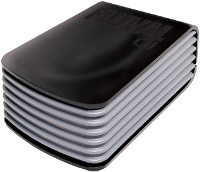
View On Amazon
| Tank Size | PSI | Outlets | Noise Level | Longevity | Price |
| 20-160 Gallons | Q1: 2.7 Q2: 3.4 |
2 | 45 dB at 1m | 1-3 Years | Medium |
Fluval Q series air pump is an above average quality air pump that runs quieter than most air pumps. It has a sturdy design, 1/2 outlets depending on size. The motors are surrounded by a triple layered casing, two thick walls and a noise suppressing baffle chamber. This is what peaked my interest and ultimately led to my purchase, as this was similar to a DIY method I used to quiet an older air pump.
The body is a bit big, the Q2 being 3″H x 7.5″L x 4.25″W and the Q1 measuring 3″H 6″L x 4″W. The cord is a hearty 6 footer, letting you place the air pump wherever you like. Its rubber feet do a great job of keeping the pump in place and reduce a lot of the vibration, making this pump far less likely to travel than the tetra whisper.
Set-up
Air pumps are plug and play, however for the best results there are a few things you should keep in mind.
First off you can make your air pump quieter by keeping it above the tank. This will help reduce the pressure in the tubing, letting the motor run with less resistance. The issue here is many tanks do not have a compartment above them, meaning the air pump cannot be hidden. This may make the pump louder than having it below the tank, hidden away in the stand.
When placing the air pump below the stand you will want an air check valve. In the event the pump stops running, water will frequently begin a reverse siphon, draining the tanks water to the air pump. This can cause a lot of damage to our floors and equipment. The air check valve is put in place to stop this. It will however make your pump slightly noisier.
The Q2 model comes with a flow control knob, which can reduce harmful back pressure on the pump, increasing the service life of the pump. The Q1 will need its own additional air control valve, however this will not reduce the pressure as efficiently as the Q2.
To help relieve back pressure, which will be the main cause of air pump failure, you should install a gang valve and allow some air to flow through it into the open room. This will help take the stress off of the pumps diaphragm.
Maintenance
After running for a few months, air pumps can create a few issues.
- The constant vibration can loosen the screws, increasing the noise generated by the pump.
- Pumps that have not been secured in place may move themselves and end up in a much noisier position, such as against the wall or other items in the stand.
- Dust can create unwanted heat, shortening the pumps life. Dust it off every once and awhile.
- Air stones, bubble wands and air tubing can all deteriorate. Combat this by having two sets of air stones/bubble wands. Clean one and allow it to rest and dry for a month before swapping the two and repeating the process.
Warranty & Lifetime
The pump has been installed in one of my downstairs tanks for over half a year with no issue, with most users reporting over a year of lifetime. Often times the pump will see over four years of use, however this is not common enough for me to state it is an average.
the Fluval Q series air pump comes with a two year warranty from the manufacturer. This will not cover damage caused by reverse siphons or if it falls and breaks, however it will cover any design faults/degradation of the pump, excluding rubber components.